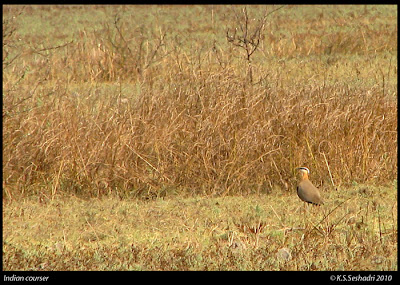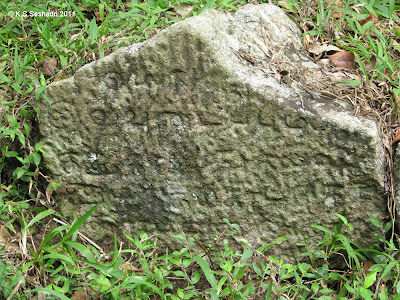If I were to make a list of disasters in my life, my brief stint at the Pondy University would be one among them. From the start, I hated the place. Maybe it was the sultry weather or the filth strewn roads (outside the white town of course!) or loud jarring music played through cheap Chinese speakers in all busses or it was just the thought of spending over a year in a place with all the above which I seriously did not look forward to. But then, eventually, things started to settle down. University life was mundane (to put it mildly) but, I had other things to keep myself occupied. Bird watching, as always topped the list.
Being a Bangalorean, and on top of it, being a student of the Ecology department, I called upon myself, the luxury to presume that most people would be passionate about natural history and nature itself. How wrong I was! Except for a few, a majority, numbering no less than 25 in the class just happened to take the course because of Environmental Sciences! Some, others joined because they wanted to do a post-graduation! A few in particular, had no foundation in basic ecology what so ever, forget the environment.
I was not new to Pondy Univ. I have had the privilege of working and learning from people who passed out of the Univ. right from the first batch, when ecology was introduced to just about mid 2000’s over a period spanning two decades. From what I understood, life was good. Pondy was nice, the campus was wild and there was a big wetland called Kalliveli, very close to the university campus.
My roommates in the hostel were also my classmates and Vivek Chandran shared similar interests of mine. He came with the expertise of wetland birds which he gained in Kole wetland in Trissur,Kerala. I knew wetland birds but was not an expert. With his expertise, we were pretty comfortable to identify most of the birds we encountered. For those who have gone to universities and have seen the world rot, the urge to make the difference is immense. We were no different. Distraught by the absence of foundation among fellow-to-be-ecologists, we invited them to join us on a bird watching trip to Kalliveli.
On a Sunday morning, armed with binocular, camera, a book, nine of us headed to the wetland by cramming ourselves in an auto. None of us had been there before and had some bit of explaining to the auto driver. The man promised to pick us up when we were finished and dropped us off at a place saying this was it.
I was in for a rude shock. The place looked like a desert. By no means a wetland. This was just after the peak summer. The water was all but gone. The grass had dried up, the ground was parched and the sun was belting down our backs as early as 9 am. We started marching and talking to people and getting to know each other a little. This was meant to be the first field trip of any kind in our class and for a few, this was the first time ever on their own!!
 |
| The baked land |
Some kept slipping and tripping over and some could not walk in the dry ground. One gentle lady who has never been in such a dry landscape showed clear signs of having sunstroke! A few hours were spent there and Vivek and myself had some bird watching opportunities in the small tanks dug within the big wetland. Fearing the sunstroke and fore thought of having to carry the lady back, drove us to head back to the university.
That day on, I was clear that we are not taking any one else along with us. I don’t know if Vivek felt the same but did not insist otherwise. The next trip did not happen for a month. We went to other wetlands. The second trip happened in December 2009. The rains had filled up the tanks and there was water. I was not prepared for the water as I had gone with my dear woodland shoes. Vivek had no problem wading right into the water while I thought a great deal before following suit. The nudge really came from a major shortfall of birding in Kalliveli. The birds are really far away. In small tanks, the birds when disturbed move to another location often close by. But in Kalliveli, the vast expanse of wetland gives the bird an opportunity to fly off and away at ease. We had to resort to crawling on ground, wading on knees in water and what not to try and approach a bird to get a decent look at it. Wading in the water for close to four hours had gotten my feet soggy and crumpled. The shoes were ever heavy and the sun was as bad as it could get. My camera had gone for repair and all that was retained were memories.
Janurary of 2010. The water had increased. There were more birds because of the winter. We were delighted by the sight of Glossy Ibises, A lone Jackal, a few ruff’s and black tailed godwits. We had creeped so close to the flock of godwits that we could hear the wisps of air as the birds took off to the air. This time around, I cleverly wore Hawaii chappals while wading. This, I realized later was a foolish thing to have done. The chappals got stuck in the clay and made walking with ease impossible. Frustrated, I had walked the tank barefoot and this caused more trouble as thorns went into the feet. That day was very eventful. Vivek had got a new SLR camera. Mine had not yet returned from repair. He was getting used to photography and we thoroughly enjoyed the birding experience. There were so many things to shoot. We continued walking and reached waist deep water. Now, the sun was really bad and we were hungry and tired. So, instead of walking back to the bund the way we came, I gave the idea of cutting across the tank t reach our cycles. And so we did. Walking back was not easier than I had thought. The reeds had grown tall to about 6 feet. We were in waist deep water and could not see what or where we were stepping. One thing we knew was the water would get deeper on the west and so we kept to the east but then, it was mid day and soon we did not know which side we were keeping to!. The reeds were tuff and my feet were bruised. There would seem to be a path only to lead to a small deep pool. To go round it, we took detours and eventually we went round in circles for over 2 hours. Finally, we reached a small tank, climbed on top of the bund and located where we were. Still over a kilometer away from the cycles. This time, we had landmarks in the backdrop and headed straight towards it and managed to reach the cycles. We must have been the only two people who got lost in a wetland!
 |
| Photo by vivek. Showing the grass in which we got lost! |
We went again and again atleast once a month for the one and half years we stayed in Pondy. Every time we went, there were surprises.Each time, a new bird added to the list. European White Storks, Eurasian Stone Plover, Indian Courser, Pratincole, Grey Headed lapwing, Black Tailed Godwit, Eurasian Curlew, Pintails, Garganey, Water Cock, Plovers, Terns, Pallid Harriers, Pied Harrier, Greater Spotted Eagle, Ruff, Pacific golden plover, Common teal, Whistling teals, Great reed warbler, and Red necked Falcons were among the distinguished birds that were lifers for me!
Once, we were walking in the vast wetland and a Coast Guard chopper hovered over us. Both of us were in camouflage and were holding cameras. The chopper made another pass over us and we began taking pictures of the chopper! The guy there was also looking at us through Binoculars! Soon after, we saw a Jackal bolt out of the grass and run for its life!
 |
| Photo by Vivek |
Another time, we were accosted by a loud mouthed forest department staff. He began yelling at us asking for permits to visit the tank and who we were? He wanted money. He would not ask and I would not give. Instead he tried bullying us around and asking us to talk to the DFO. I pulled out my phone and said give his number. At which he became quiet and let us go, warning us to inform them the next time we visit. That was the last I saw of any human being there. Only other time I saw people was during grass harvest season. The reed/grass which grows in the tank is harvested in cartloads by locals and made into mats and brooms.
Now, I have passed out of the Univ. Life has come to what it was before, peaceful and pleasurable. The madness of Pondy does haunt me at times. But the Kalliveli tank, the cool waters, hot sun, muck and flying beauties haunts me more than ever. Vivek and Myself did visit Kalliveli before parting ways. I do not clearly remember when but vaguely remember it to be an evening of November. We saw a jackal and a few waders in flight. The fading sun turned the entire tank shimmering gold.
We were to do one last trip before parting ways after doing our Masters Dissertation work. Unfortunately, this never happened. When we met again in May, to submit our reports, it was peak summer and there would be no birds in the wetland. The trip got postponed and so far, it has never happened. We defended our dissertations and got results that we passed the MSc. He is back in Kerala and I am back in Bangalore. Kalliveli must be as lively as it was in the past.
 |
| Photo by Vivek when a red necked falcon zipped past! |
I must confess, if there was one thing I liked and am actually missing in Pondy. It is this wetland. I cannot seem to get enough of it. In all the 20 odd trips we did, we have never reached the other end of this huge wetland and that should give you an idea of its vast nature. The days spent cycling to the tank, walking in the muck, wading in water and getting lost are among the most pleasant things that happened on bird watching trips. The lengths we went to identify the birds, watch them up close and relish the joy until the next month are fresh in my memory. Hoping that someday, that ‘one last trip’ trip will happen, followed by many more.
PS: Photos shot by Hopeland, My junior in the university and the amazing birds he has been seeing pushed me into writing this. He can be found here.





























